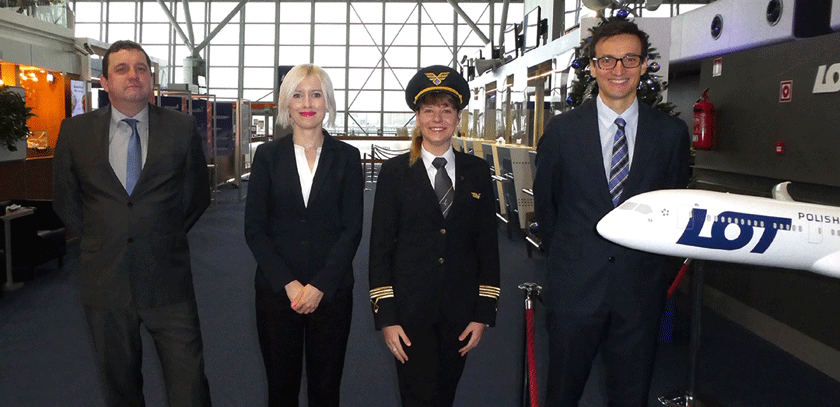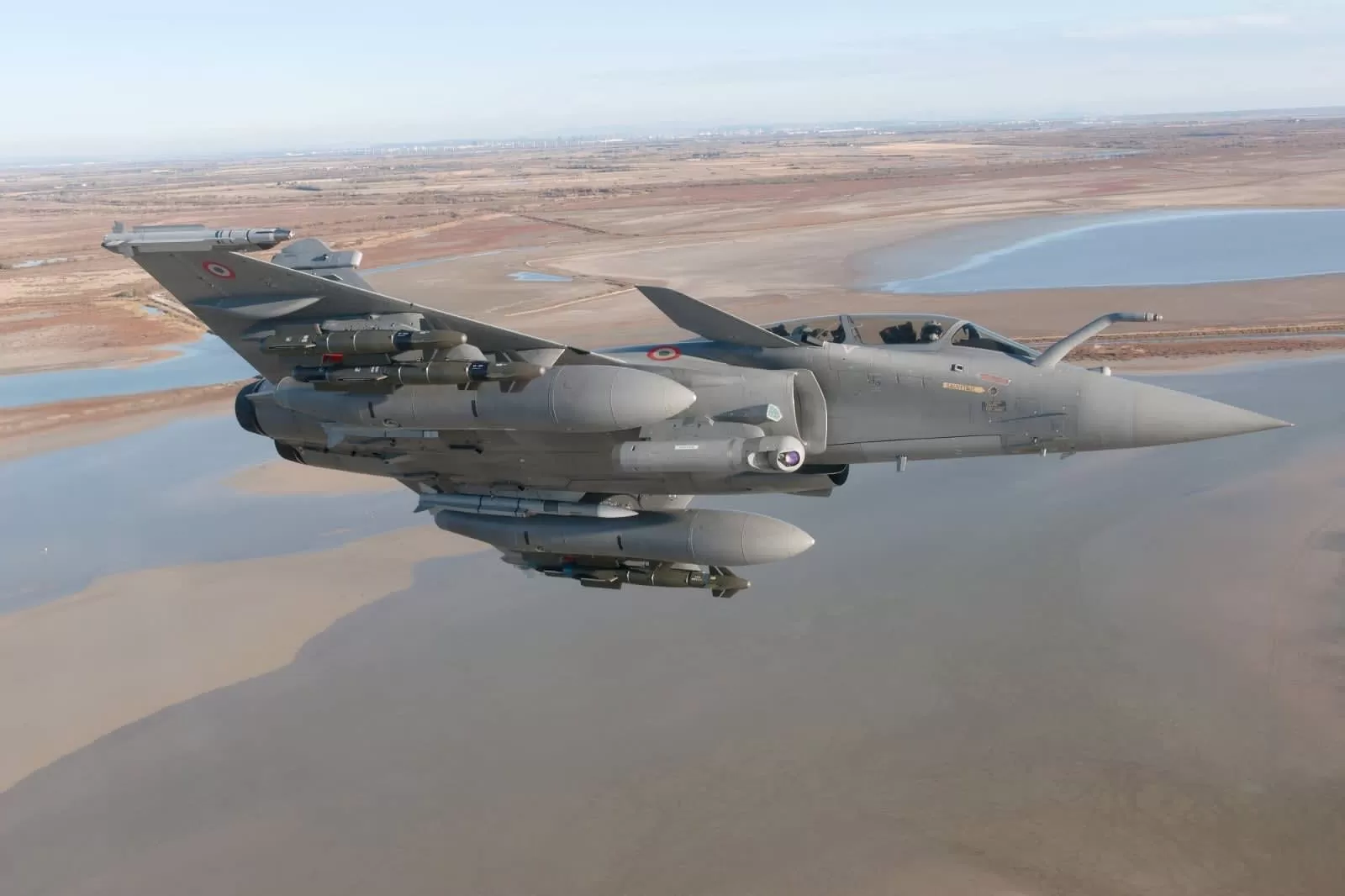
Paperless cab?

Leszek Teivan's team with the author of the text at the Chopin airport, from left to right: Lukasz Rodzewicz Cigan, Joanna Vechorek, Captain Katarzyna Gojny, Leszek Teivan.
About the digitization of paper documentation in the cockpit – Leszek Teivan, Head of Aviation Procedures at PLL LOT, together with her team, spoke about Joanna Vechorek, an aviation law expert working with Dentons.
Joanna Vechorek: Mr. Leszek, at PLL LOT you are in charge of the aviation procedures department and are responsible for a project that can be summed up in two words: cockpit digitization. Did the tablets almost completely replace the paper from the cab very quickly? Sign of the times or necessity?
I will be Tejwan: So far, thick, thick folders with the necessary “work papers” for the flight, maps, flight plan, etc. along with a uniform and a good watch, they were the well-known attributes of a line pilot. The now ubiquitous IT systems have also revolutionized the documentation required by flight crews. Based on these needs, an IT system was created - the Electronic Flight Bag (EFB), which is necessary for the pilot (the translation of the EFB entered into the regulations is the electronic pilot bag). Over the past 15 years, EFB systems in various configurations have become a specialized tool for air operations. The EFB system can be the pilot's personal equipment, taken from the cockpit after the flight (Portable EFB, Portable EFB) or can be an integral part of the aircraft's on-board equipment (Installed EFB, EFB Stationary). In the case of a portable EFB system, a commercially available tablet is usually used, mounted in the cab with a handle that allows it to be placed in a comfortable position in the cab. There are also systems for powering tablets from the onboard network and interfaces that allow you to connect the EFB to onboard systems, for example, to use communication channels and download data to the EFB software. Experience with EFB systems shows that devices with a screen size of 10 to 12 inches screen diagonal with Windows or iOS operating systems are best suited for this role.

Hubert Podgórski, First Pilot of the Boeing 787 Dreamliner, Preparing for
cruise with EFB, possibly at home.
JW: This cockpit revolution was initiated by Mr. Captain Krzysztof Lenartowicz in 2012 and started with the EFB Stationary on the Dreamliner and then spread to other fleets. Implementing the system uniformly across airlines with different types of aircraft is not easy.
LT: Right. Airlines that base their business on only one type of aircraft have a much easier time. Since 2012, PLL LOT has operated state-of-the-art Boeing 787 Dreamliner aircraft, which have been using "EFB Stationary" from the very beginning, i.e. permanently built into the cockpit EFB system, which allows the use of navigational documents and operational documentation in electronic form. Start. About 5 years ago, a project was launched to extend EFB to the remaining fleets: Boeing 737, Dash 8 - Q400 and Embraer 170 and 190. This type of system, unlike the "EFB Stationary" on Dreamliner aircraft, is "EFB". Portable", where the carrier of all navigation and operational data is a tablet. The solution was to assign a tablet to each remote control ("EFB Tablet Pilot Attached"). The solution is aimed at providing communication between the pilot and the company, providing the crews with corporate and training documentation and, above all, providing all the navigation and operational documentation necessary for the flight.
JWA: Tablets must, of course, meet EASA/FAA certification requirements for use in the cockpit. When did you start EFB Portable certification?
LT: In 2018, LOT began the process of certifying the portable EFB system in all fleets. As a result of a certification process and several reviews by the Civil Aviation Authority, the EFB Portable system has been approved for operation in the following areas:
- hardware (tablets and certified tablet holders with power supply and GSM modems permanently fixed in the cockpits):
- for the use of a navigation system that provides all charts of routes, approaches and aerodromes for flight, including all information necessary for flight operations. In 2019, the implementation and certification of the Flightman application began, aimed at providing complete flight crew reporting information and providing up-to-date operational documentation to each pilot.
This process culminated in 2020 with a final audit conducted by the Civil Aviation Authority, which resulted in LOT being granted the right to use electronic operational documentation when performing flights. Currently, LOT does not transport paper operational and navigational documentation in cockpits, due to which more than 40 kg of documents are lost in each cockpit. Particular attention should be paid to the long-term certification process, when the system evaluation period for each park was six months. This was also due to the special training of crews on the use of the EFB Portable system. Removing many kilograms of paper from the decks of aircraft allows, among other things, to provide measurable savings in fuel consumption, which translates into a reduction in CO2 emissions and significant financial savings due to reduced aircraft weight and economies of scale in the fleet used.
JW: Captain, you support Leszek Teivan's team in the implementation of the EFB Portable at LOT Polish Airlines. Certainly, the knowledge you gained while studying aerospace engineering at the Faculty of Energy and Aerospace Engineering of the Warsaw University of Technology helps you to carry out your daily duties.
Katarzyna Goyny: Yes, I think that was the decisive factor in choosing me for this team, and I am happy to put my knowledge into practice. On the Embraer 170/190 aircraft that I fly as captain, the pilot uses the “EFB Portable” system, i.e. tablet, where he has access to navigation and operational data. The term EFB (Electronic Flight Bag) means a system that allows you to store, update, distribute, present and / or process data. This system is intended for flight crews in terms of operational support or tasks performed on board the aircraft. Each of the pilots has a branded tablet. In the cockpit, the tablets are placed by the crew in special holders - the captain has a tablet on the left, the senior officer has a tablet on the right. Before these devices appeared in aircraft cockpits, they had to go through a certification process. This process required the preparation of appropriate procedures, testing and preparation of operational and training documentation. I also took an active part in these tests.
JW: Captain, already at the stage of preparing the crew for the flight, the tablet is used to analyze the available information about the trip. Please introduce readers to the use of the EFB system in back-to-back air operations.
kg: In preparation for the flight in the so-called. The “briefing room”, that is, the pre-flight room, each pilot is required to update the data on the tablet in the applications that will be used during the cruise. This is possible after connecting the tablet to the Internet. After the tablet is synced, the apps display the correct update messages. The flight path is available in the Jeppesen FliteDeck Pro app installed on the tablet. This application is used for viewing flight data, in-flight navigation and is a backup source of operational documentation. In addition, it contains current and forecast weather for airports, i.e. METAR and TAF, as well as various weather layers, including cloud layers, turbulence, icing, lightning and winds. On the displayed flight path map, you can view the weather layer in question. Thanks to this solution, already during the flight preparation phase, pilots can see whether, for example, the flight path passes through turbulence zones or areas of strong wind.
During the flight, pilots use the Jeppesen FliteDeck Pro app for navigation. Route Charts, Standard Arrivals Charts, and SID Charts - Standard instrument departures, approach charts, and airport charts, including taxiways and parking lot identification (airport and taxi charts). Compared to paper maps, the big advantage of using such a tool is that all the necessary maps are in one place - the application allows the user to create quick access tabs, for example. to the maps that are used in this flight. Another advantage is the ability to scale the map, i.e. magnification of a given area, where one scale is available for paper maps. In addition, the application has the ability to write on maps, which allows the pilot to write down his notes or mark important information. During the flight, you can also quickly open the documentation for the selected airport, for example, the airport on the route, where in the case of a folder with several dozen airports in paper form, this would take longer.
JW: Thus, it can be summarized that the EFB system is a fast "relay" of navigational and operational documentation. At LOT Polish Airlines you also act as a navigator pilot. As part of this function, you, in particular, prepare navigational documentation for pilots. related to the procedures and regulations applicable on a given route and at a given airport?
kg: Yes that's right. Before flying, each pilot is familiarized with this navigation documentation, which is available at the tablet level, in the Jeppesen FliteDeck Pro app in a dedicated tab. This is a convenient solution because the remote control has direct access to these documents. The use of electronic documentation also allows for its rapid distribution and updating - the application displays a message about the availability of a new update, after which the pilot, after synchronization, can read the new version of the document. This solution significantly improves the distribution of navigation and operational documentation in comparison with its delivery in paper form to aircraft.
